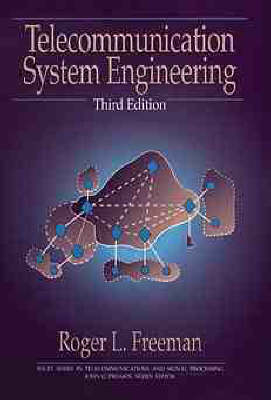
Telecommunications System Engineering
John Wiley & Sons Inc (Verlag)
978-0-471-13302-5 (ISBN)
- Titel erscheint in neuer Auflage
- Artikel merken
The field of telecommunications is a rapidly growing one, with the bulk of the industry predicated on the telephone or PSTN (Public Switched Telecommunica-tion Network). The primary goal of Telecommunication System Engineering, Third Edition is to describe the development of the PSTN, the rationale behind its structure, and how dramatically it is evolving. Telecommunication System Engineering, Third Edition presents a technical overview of telecommunication networks from a system viewpoint, with the aim of showing how one discipline can interact with another to reach a desired goal. As in previous editions, the author covers all the concepts necessary for a complete understanding of the design of practical telecommunication networks, whether they are meant to carry voice, data, facsimile, telemetry, video, or any combination of these. Both local and long distance (toll) switching and transmission are covered, all in great detail, and two entire chapters are devoted to the subject of signaling. For the Third Edition, the author has amended and reorganized his material to include the latest technology in the industry.
For example, Chapter 6 has added material on new traffic routing techniques in the national network, and network design and configurations from a Bellcore perspective, while Chapter 7 features new material on line-of-sight microwave systems and satellite communications. Chapter 8 covers the latest developments in digital loop carrier, SONET and SDH, and delta modulation, and Chapter 11 offers new information on TCP/IP and related protocols, as well as IBM system network architecture (SNA). Two entire chapters have been added on emerging broadband-data technologies and the asynchronous transfer mode (ATM). In addition, chapters have also been added on cellular/mobile radio and PCN/PCS and network management techniques. As in previous editions, the author approaches the information covered in a systematic and interactive way. Each chapter builds logically on the previous one, and the various disciplines are tied together with an eye toward combining them in the design of efficient and cost-effective telecommunication networks.
Telecommunication System Engineering, Third Edition remains an ideal reference source for telecommunications managers, technicians, and other practicing professionals as well as advanced students in telecommunications. Many changes have taken place in the field of telecommunications since the Second Edition of the popular and successful Telecommunication System Engineering was published in 1989. The Third Edition marks a major and groundbreaking revision of what is already a widely used and highly acclaimed text. As in previous editions, the author presents intertwining disciplines in a systematic and interactive way. To reflect recent developments in the field, the author has added chapters on such vital topics as cellular radio, asynchronous transfer mode, broadband technologies, and network management.
Contents of the Third Edition include: Some Basics in Conventional Telephony Local Networks Conventional Analog Switching in Telephony Signaling for Analog Telephone Networks Introduction to Transmission for Telephony Long-Distance Networks The Design of Long-Distance Links Digital Transmission Systems Digital Switching and Networks Introduction to Data Communications Data Networks and Their Operation Local Area Networks Integrated Services Digital Networks Emerging Broadband Data Technologies The Asynchronous Transfer Mode and Broadband ISDN CCITT Signaling System No. 7 Cellular/Mobile Radio and PCN/PCS Network Management
ROGER L. FREEMAN is founder and principal of Roger Freeman Associates, independent consultants in telecommunications, specializing in system engineering in Hispanic America. In the course of over 45 years' experience in telecommunications operations, maintenance, and engineering, he has served as principal engineer for advanced system planning at the Raytheon Company, technical manager for ITT Marine Europe, and regional planning expert for the International Telecommunications Union (ITU), among other positions. In addition to the two previous editions of Telecommunication System Engineering, Mr. Freeman has written four other books on the subject of telecommunications engineering: Reference Manual for Telecommunications Engineering, Second Edition; Radio System Design for Telecommunications; Practical Data Communications; and Telecommunication Transmission Handbook, Third Edition, all published by Wiley. A senior life member of the IEEE, Roger Freeman has lectured at numerous professional conferences and published widely in international telecommunication journals.
Partial table of contents: Some Basics in Conventional Telephony. Conventional Analog Switching in Telephony. Signaling for Analog Telephone Networks. Long-Distance Networks. The Design of Long-Distance Links. Digital Transmission Systems. Digital Switching and Networks. Introduction to Data Communications. Data Networks and Their Operation. Local Area Networks. Integrated Services Digital Networks. Emerging Broadband Data Technologies. CCITT Signaling System No. 7. Cellular/Mobile Radio and PCN/PCS. Network Management. Index.
| Erscheint lt. Verlag | 7.6.1996 |
|---|---|
| Reihe/Serie | Wiley Series in Telecommunications and Signal Processing |
| Zusatzinfo | Illustrations |
| Verlagsort | New York |
| Sprache | englisch |
| Maße | 163 x 243 mm |
| Gewicht | 1616 g |
| Einbandart | gebunden |
| Themenwelt | Technik ► Nachrichtentechnik |
| ISBN-10 | 0-471-13302-7 / 0471133027 |
| ISBN-13 | 978-0-471-13302-5 / 9780471133025 |
| Zustand | Neuware |
| Haben Sie eine Frage zum Produkt? |
aus dem Bereich



